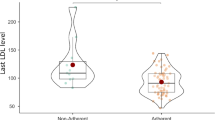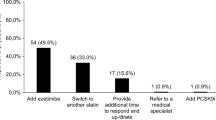Abstract
Background: Statins are frequently prescribed drugs for patients with coronary heart disease according to evidence-based medicine. However, compliance with these agents has still been far from ideal, since they require long term, probably life long therapy. We conducted a survey on patients who were already on statin treatment and evaluated their level of awareness of prescribed statins.
Methods: 236 participants (117 male, 119 female), who had been on treatment with statins for at least three months, were enrolled in our study after giving informed consent. Patients were asked close-ended survey questions.
Results: Only 5.5% of participants were on statin treatment for primary prevention, and 16.1% of them had a CHD equivalent, defined as those with clinical manifestations of noncoronary forms of atherosclerotic disease (peripheral arterial disease, abdominal aortic aneurysm, carotid artery disease) and diabetes mellitus. Most participants (70%) stated that they had been using statins to decrease cholesterol, whereas 16.5% stated that they had no idea. More than half of the participants (58%) stated that they did not know how long they would have to keep using their statins, whereas 21% replied that they would use them continuously. One fifth of participants had some idea about side effects. Participants in whom statin therapy was started during hospitalisation for coronary angiography and/or PCI more frequently answered that statins should be used continuously (49% vs. 12% not hospitalised, p < 0.01). Also, therapy adjustment by the physician led to a better understanding of the need for continuous use (55% vs. 31% without medication change, p < 0.001), as was the case for patients with < 2 comedications (36% vs. 17% with > 2 comedications, p 0.002). Presence of other risk factors did not have any impact on level of awareness.
Conclusion: Comprehensive information at initial prescription, initiation of statins during hospitalization, dose adjustment during follow up, and as little co-medication as possible seem to increase the level of awareness of the benefits of long-term statin treatment. This might result in better compliance rates.
Similar content being viewed by others
References
Scandinavian Simvastatin Survival Study Group. Randomised trial of cholesterol lowering in 4444 patients with coronary heart disease. The Scandinavian Simvastatin Survival Study (4S). Lancet 1994;344:1283–1289.
The Long Term Intervention with Pravastatin in Ischaemic Disease (LIPID) Study Group. Prevention of cardiovascular events and death with pravastatin in patients with coronary heart disease and a broad range of initial cholesterol levels. N Engl J Med 1998;339:1349–1357.
Downs JR, Clearfield M, Whitney E, et al. Primary prevention of acute coronary events with lovastatin in men and women with average cholesterol levels. Results of AFCAPS/TexCAPS. JAMA 1998;279:1615–1622.
Feussner G. HMG-CoA reductase inhibitors. Curr Opin Lipidol 1994;5:59–68.
Executive Summary of The Third Report of The National Cholesterol Education Program (NCEP) Expert Panel on Detection, Evaluation, and Treatment of High Blood Cholesterol In Adults (Adult Treatment Panel III). JAMA 2001;285:2486–2497.
Pedersen TR, Tobert JA. Benefits and risks of HMG-CoA reductase inhibitors in the prevention of coronary heart disease: A reappraisal. Drug Saf 1996;14:11–24.
Insull W. The problem of compliance to cholesterol altering therapy. J Intern Med 1997;241:317–325.
Simons LA, Levis G, Simons J. Apparent discontinuation rates in patients prescribed lipid-lowering drugs. Med J Aust 1996;164:208–211.
Davis DA, Thomson MA, Oxman AD, Haynes RB. Changing physician performance: A systematic review of the effect of continuing medication education strategies. JAMA 1995;274:700–705.
Raynor DK, Booth TG, Blenkinsopp A. Effects of computer generated reminder charts on patients’ compliance with drug regimens. BMJ 1993;306:1158–1161.
Tolmie EP, Lindsay GM, Kerr SM, Brown MR, Ford I, Gaw A. Patients’ perspectives on statin therapy for treatment of hypercholesterolaemia: A qualitative study. Eur J Cardiovasc Nurs 2003;2(2):141–149.
Becker DM, Raqueno JV, Yook RM, et al. Nurse-mediated cholesterol management compared with enhanced primary care in siblings of individuals with premature coronary disease. Arch Intern Med 1998;158:1533–1539.
Kim YS, Sunwoo S, Lee HR, et al. Korea Post-Marketing Surveillance Research Group. Determinants of non-compliance with lipid-lowering therapy in hyperlipidemic patients. Pharmacoepidemiol Drug Saf 2002;11(7):593–600.
Wei L, Wang J, Thompson P, Wong S, Struthers AD, MacDonald TM. Adherence to statin treatment and readmission of patients after myocardial infarction: A six year follow up study. Heart 2002;88(3):229–233.
Horwitz RI, Horwitz SM. Adherence to treatment and health outcomes. Arch Intern Med 1993;153:1863–1868.
Cannon CP, McCabe CH, Bentley J, Braunwald E. Early statin therapy is associated with markedly lower mortality in patients with acute coronary syndromes: Observations from OPUS-TIMI-16 [abstract]. J Am Coll Cardiol 2001;35:334A.
Muhlestein JB, Horne BD, Bair TL, et al. Usefulness of in-hospital prescription of statin agents after angiographic diagnosis of coronary artery disease in improving continued compliance and reduced mortality. Am J Cardiol 2001;87:257–261.
Abraha I, Montedori A, Stracci F, Rossi M, Romagnoli C. Statin compliance in the Umbrian population. Eur J Clin Pharmacol 2003;59(8–9):659–661.
Birtcher KK, Bowden C, Ballantyne CM, Huyen M. Strategies for implementing lipid-lowering therapy: Pharmacy-based approach. Am J Cardiol 2000;85(suppl):30A–35A.
Blair TP, Bryant FJ, Bocuzzi S. Treatment of hypercholesterolemia by a clinical nurse using a stepped-care protocol in a nonvolunteer population. Arch Intern Med 1988;148:1046–1048.
LaRosa JH, LaRosa JC. Enhancing drug compliance in lipid-lowering treatment. Arch Fam Med 2000;9(10):1169–1175.
Author information
Authors and Affiliations
Corresponding author
Rights and permissions
About this article
Cite this article
Yilmaz, M.B., Biyikoglu, S.F., Guray, Y. et al. Level of Awareness of on-Treatment Patients About Prescribed Statins. Cardiovasc Drugs Ther 18, 399–404 (2004). https://doi.org/10.1007/s10557-005-5065-9
Issue Date:
DOI: https://doi.org/10.1007/s10557-005-5065-9




